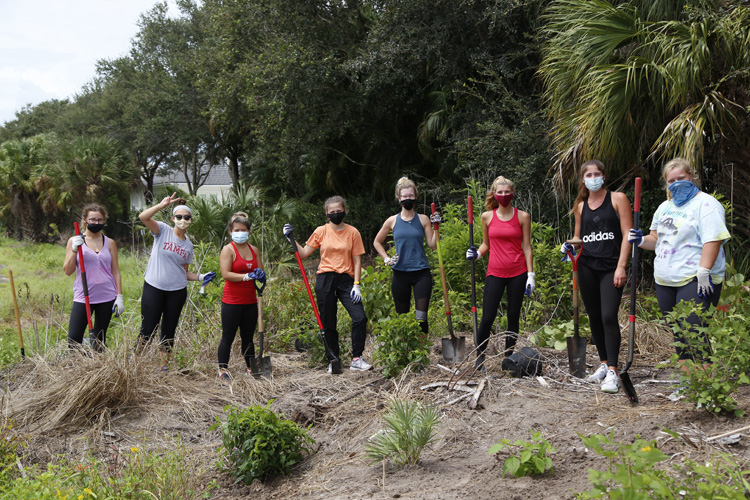The Jones Pier Conservation Area was a beehive of activity recently, as volunteers from the Pelican Island Audubon Society, Florida Native Plant Society and University of Tampa students assisted Indian River County staff with the site’s most recent enhancements.
The 16-acre property along Jungle Trail is one of numerous environmentally and/or historically significant sites acquired through the Indian River County Conservation Lands Program.
“This is one of many sites that we’re working on; getting it open to the public so people can come out and enjoy these lands that were purchased,” said Beth Powell, Conservation Lands manager.
Among the area’s earliest settlers, the Jones family farmed the land and built Jones Pier in 1907, tending it for multiple generations as a lifeline for supplies before bridges connected the mainland to the barrier island. The property extends back from the pier and the family home. Plans call for the house to become a museum, with adjacent parking and a pavilion with restrooms.
The conceptual design process for improvements to the site, which was overrun with myriad exotic plants, began about three years ago.
“We purchased about 1,700 native plants and the Pelican Island Audubon Society gave us 50 Live Oaks so we will be planting those as well. We have volunteers who are assisting us with putting all the plants in the ground, as clearly that’s more than just a few staff people can do,” said Powell.
She said they hope to open the site’s 1-mile trail to the public early next year.
“Originally the goal was that this would be planted as a maritime hammock. But nobody in our lifetime would ever be able to enjoy it; it takes hundreds of years for a maritime hammock to become mature, like Captain Forster’s,” said Powell.
The 110-acre Captain Forster Hammock Preserve Conservation Area is a river-to-ocean parcel 1 mile north of Jones Pier.
Instead, because the declining health of the Indian River Lagoon remains an issue, they dug out what will be a 4-acre saltmarsh when it is eventually connected to the lagoon through a series of culverts.
“The salt marsh looks like it’s just one layer, but it’s actually very contoured on the inside, so there’s different water depths. Some of the deepest points are about 8 feet deep and then most of it is around 2 to 3 feet, which is suitable for saltmarsh plants to grow,” said Powell. “The idea is that we will be filtering the lagoon water through the saltmarsh. The plants will uptick nutrients and help to clean and purify the water, and then it’ll go back out to the lagoon cleaner than it came in.”
To the east of the saltmarsh will be an enhanced gopher tortoise sanctuary. Other planned sections include a hydric hammock to also filter water, and a native plant nursery, where seeds and plants could be grown for use on other conservation areas.
In an area where native wildflowers will initially be seeded, she hopes long-term to have a community garden similar to one she has seen in Sarasota.
“What we’re doing today is to improve the habitat that people will see if they’re coming out to bike or walk. The whole loop from the parking lot around is 1 mile, so it’s a nice trail.”
A recent grant from the Division of Historical Resources will go toward the structural analysis and engineering of the main house and, as it was flooded by Hurricane Matthew, they are working with FEMA on a Hazard Mitigation grant to elevate the house by 8 feet. They have also applied for a grant from the Florida Inland Navigation District to fund museum exhibits.
Photos by: Kaila Jones
Click HERE to see more or buy photos

